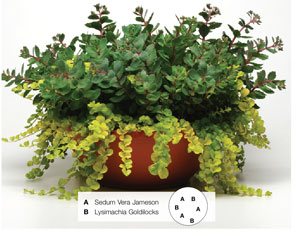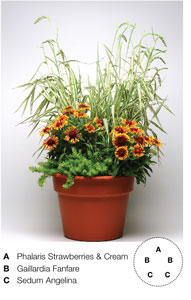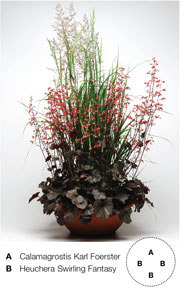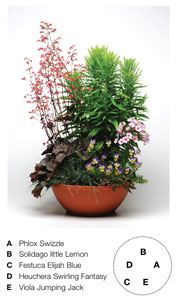9/15/2010
Perennial Container Solutions
Joan Mazat

Mixed combination containers continue to be a growing segment of our market. They provide instant gratification to homeowners and take the guesswork out of what plants will grow together for the consumer. With this growth, we need to continue to explore using different crops to increase interest and assist in the end consumer’s success. Using perennials in mixed containers is an excellent option to reach these goals and offers numerous benefits that annuals may not provide. It’s also a way growers and retailers can continue to drive container sales.
Designer Dos
• A single perennial combination can be created with plants that bloom in early, mid, and late spring through the end of summer. Perennial foliage offers attractive texture prior to and after flowering. This offers a changing seasonality for the consumer and provides the benefits of a “mini garden.”
• Perennial grasses, sedums, achillea and artemisia give containers textures that annuals simply can’t provide.
• Color and texture can be achieved using perennials that are not used primarily for flowers.
Perennials For the Perfect Pot
Vernalized Liners
Achillea millefolium Little Susie
Aquilegia Winky Blue White
Arenaria montana Flurry
Delphinium Dasante Blue
Heuchera Swirling Fantasy
Phlox Swizzle
Scabiosa Harlequin Blue
Sedum Vera Jameson
Veronica Royal Candles
Non-Vernalized Liners (liner tray sizes 50-102)
Echinacea PowWow Wild Berry
Festuca Elijah Blue
Gaillardia Fanfare
Juncus Javelin
Lysimachia Goldilocks
Phalaris Strawberries & Cream
Sedum Angelina
Solidago Little Lemon
Calamagrostis Karl Foerster
Carex flagellifera Bronzita
Cerastium tomentosum Snow in Summer



Scheduling
Here is the schedule and brief culture for creating these perennial combinations planted from liners directly into 14-in. containers.
• These recipes were started in Week 9, as some genera required bulking under short days in northern Illinois.
• Be sure to incorporate slow-release fertilizer into the soil before transplanting liners directly into the finished containers.
• Start in a warm house with night temperatures approximately 62F (16.7C) for the first 10 days to “awaken” dormant liners after transplant.
• Once active growth and rooting begin, drop to 50F (10C) night temperatures with ambient day temperatures. Open-sided greenhouses/cold frames are ideal.
• In mid April, containers can be moved outdoors for toning and finishing. It’s amazing to see how fast they grow from this point on! Provide protection from late frost.
• Containers are expected to be “retail ready” mid May.
• Vernalization is needed for some genera to bloom the first year. Keep this in mind when planning for and ordering your inputs.
Consumer Benefits
Be sure to explain these benefits of perennial combo containers to your customers. Not only will they be walking away with a great combo, they’ll also be willing to pay extra for it!
• No worries of spring frosts as cool temperatures will only make the color and plant quality better. Most perennials are tougher than annuals!
• Perennial combos have lower water requirements. This is a great advantage for the beginner gardener and those with busy schedules—plus, it’s good for the environment.
• Perennial sedums come in many different shapes, sizes, and flower and foliage color, making them an excellent choice for both their appearance as well as low water needs.
• Perennial ferns, heucheras and lamiums provide a plethora of color and texture options and are a welcomed change for consumers looking for shade options.
• Consumers can plant the perennials in their garden in the late summer and see them reappear in the spring!
Grower Benefits
Being valuable to the consumer is one thing. What about the benefits to you, the grower-retailer?
• Slow-release fertilizer in the soil at time of planting eliminates the need for liquid feed, thereby cutting down on labor and fertilizer costs.
• Plant growth regulators are not needed.
• Limited pinching and pruning are needed.
• These are an expanded upscale offering to your customers!
GP
About the Author: Joan Mazat is the Business Manager for Potted Plants, Cut Flowers, Poinsettias & the Lead of the “Container Solutions” Committee for the Ball Horticultural Company. This project was part of the Darwin Perennial Day held at Ball in June of 2010, which will become an annual event.